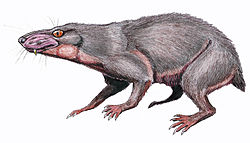| Regisauridae Temporal range: | |
|---|---|
 | |
| Restoration of Regisaurus | |
| Scientific classification | |
| Domain: | Eukaryota |
| Kingdom: | Animalia |
| Phylum: | Chordata |
| Clade: | Synapsida |
| Clade: | Therapsida |
| Clade: | † Therocephalia |
| Superfamily: | † Baurioidea |
| Family: | † Regisauridae Hopson & Barghausen, 1986 |
| Genera | |
Regisauridae is an extinct family of small carnivorous theriodonts from the Late Permian and Early Triassic of South Africa and China. [1]


